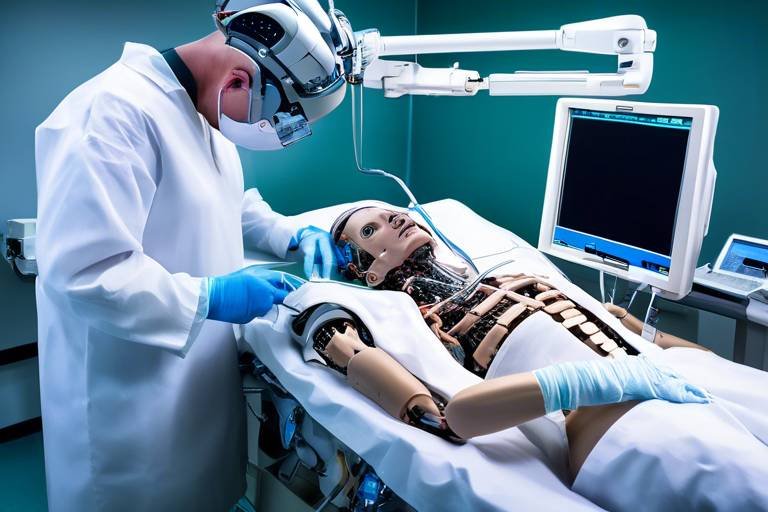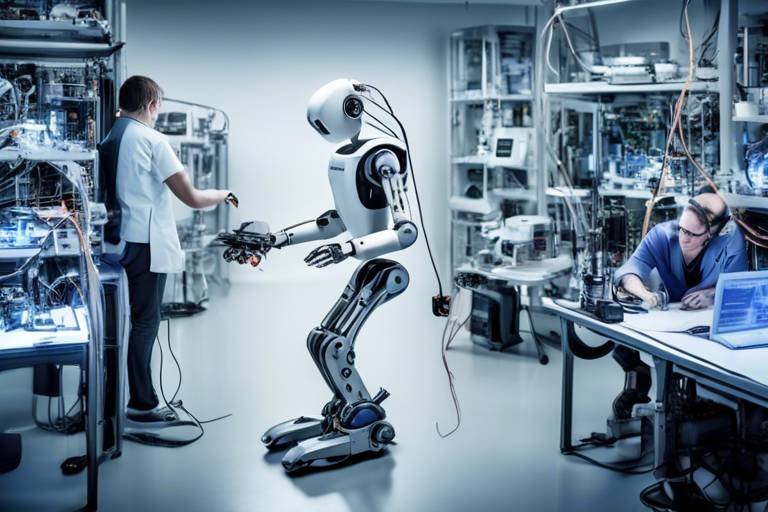How Robotics is Advancing Surgical Procedures
The landscape of surgery is undergoing a **remarkable transformation** thanks to the integration of robotics. Imagine a world where surgical precision is enhanced to the point where even the most complex procedures can be performed with minimal invasiveness and maximum efficiency. This is not just a dream; it's the reality that robotic surgery brings to the operating room. As we delve deeper into this topic, you'll discover how robotics is not only changing the way surgeries are performed but also revolutionizing patient outcomes and setting new standards for medical excellence.
Robotic surgery is a fascinating blend of **cutting-edge technology** and medical expertise. Over the years, we have witnessed the evolution of surgical robots from simple assistive devices to sophisticated systems capable of performing intricate procedures with unmatched precision. These advancements have paved the way for a new era in healthcare, where surgeons are equipped with tools that enhance their capabilities and improve patient safety. The integration of robotics into modern medical practices has become essential, as it allows for a level of control and accuracy that was previously unattainable.
One of the most exciting aspects of robotic surgery is its **ability to minimize human error**. Traditional surgical methods often rely on the surgeon's steady hands and keen eye, but with robotic systems, these elements are augmented by technology that ensures each movement is precise and deliberate. Surgeons can now perform delicate maneuvers that require a level of steadiness and focus that can be challenging to maintain during lengthy procedures. This shift not only benefits the surgeons but also significantly enhances the overall experience for patients.
As we explore the advancements in surgical robotics, we can’t overlook the **impact on patient outcomes**. With robotic-assisted surgeries, patients experience shorter recovery times, less pain, and smaller incisions, leading to reduced scarring. This means that patients can return to their daily lives much quicker than with traditional surgical methods. The benefits are clear: faster recovery, less discomfort, and a more positive overall experience. It's a win-win situation for everyone involved!
In conclusion, the advancements in robotic surgery represent a monumental leap forward in the field of medicine. The combination of enhanced precision, reduced recovery times, and improved patient satisfaction paints a bright future for surgical procedures. As technology continues to evolve, we can only anticipate further innovations that will redefine the standards of care in healthcare. The journey of robotics in surgery is just beginning, and the possibilities are truly **endless**.
- What is robotic surgery?
Robotic surgery involves the use of robotic systems to assist surgeons in performing surgical procedures with enhanced precision and control.
- What are the benefits of robotic surgery?
Benefits include reduced recovery times, minimized scarring, enhanced surgical precision, and overall improved patient outcomes.
- Are there any risks associated with robotic surgery?
As with any surgical procedure, there are risks involved. However, robotic surgery aims to minimize these risks through precision and control.
- How is training conducted for robotic surgery?
Surgeons undergo extensive training, including simulation and hands-on practice, to master the robotic systems before performing surgeries.
- What does the future hold for surgical robotics?
The future looks promising with ongoing innovations and research aimed at improving robotic systems and expanding their applications in various medical specialties.

Overview of Surgical Robotics
Surgical robotics is a fascinating fusion of cutting-edge technology and medical expertise that has transformed the landscape of surgical procedures. Imagine a world where surgeons can perform intricate operations with the precision of a master craftsman, all thanks to robotic systems. This field has evolved significantly over the past few decades, moving from rudimentary machines to sophisticated systems that enhance the capabilities of surgeons in remarkable ways.
The journey of surgical robotics began in the late 20th century, with early prototypes designed to assist in specific types of surgery. As technology advanced, so did the complexity and functionality of these robots. Today, surgical robots are equipped with advanced features such as 3D visualization, articulated instruments, and real-time feedback, allowing surgeons to perform delicate procedures with enhanced control and accuracy.
One of the most notable advancements in this field is the development of the da Vinci Surgical System, which has become synonymous with robotic-assisted surgeries. This system allows surgeons to operate through tiny incisions, using robotic arms controlled from a console. The integration of robotic systems into modern medical practices has not only improved surgical outcomes but also paved the way for minimally invasive techniques that benefit patients greatly.
As we look at the current landscape, it's clear that surgical robotics is not just a passing trend but a vital component of modern healthcare. The ability to achieve greater precision and control has made robotic surgery an attractive option for many medical specialties, including urology, gynecology, and orthopedics. The ongoing research and development in this area promise even more exciting innovations on the horizon, making it an exhilarating time to be involved in surgical robotics.
In summary, surgical robotics represents a significant leap forward in how surgeries are performed. With its roots in early technological experimentation, it has blossomed into a crucial element of modern surgical practice. As we continue to explore the benefits and applications of this technology, it’s essential to recognize the impact it has on patient care and the future of medicine.

Benefits of Robotic Surgery
Robotic surgery is not just a buzzword in the medical field; it’s a groundbreaking advancement that is changing the landscape of surgical procedures. Imagine a world where surgeons can perform complex operations with the precision of a watchmaker. This is the reality that robotic surgery brings to the table. With its innovative technology, it offers a plethora of benefits that significantly enhance patient outcomes and overall satisfaction.
One of the most striking advantages is the reduction in recovery times. Traditional surgeries often leave patients with large incisions that take longer to heal. In contrast, robotic systems utilize minimally invasive techniques, which means smaller incisions and less trauma to the body. This not only leads to quicker recovery but also reduces the risk of complications. Patients can often return to their daily activities in a fraction of the time compared to conventional surgery. Isn’t that a game changer?
Moreover, robotic surgery minimizes scarring, which is a significant concern for many patients. The smaller incisions required by robotic systems lead to less visible scars, allowing patients to feel more confident in their appearance post-surgery. For those who prioritize aesthetics, this is a huge plus!
But wait, there’s more! The enhanced surgical precision provided by robotic systems is another critical benefit. These advanced machines allow surgeons to execute intricate maneuvers that are often impossible with traditional methods. Imagine trying to thread a needle while wearing gloves; it’s challenging, right? Now, think of a robotic system that gives surgeons the dexterity to perform delicate procedures with ease. This precision not only improves surgical success rates but also reduces the likelihood of errors during operations.
With robotic systems, surgeons gain access to a level of control that is simply unparalleled. The technology allows for a 360-degree range of motion, enabling surgeons to navigate complex anatomical structures with ease. This is particularly beneficial in procedures that require a high degree of accuracy, such as prostatectomies or cardiac surgeries. The result? Better outcomes for patients and a reduction in the need for follow-up surgeries.
Minimally invasive robotic procedures have revolutionized the way surgeries are performed. By using tiny cameras and instruments, surgeons can operate through small incisions, which leads to less postoperative pain and quicker healing times. Patients are often amazed at how little discomfort they experience compared to traditional surgery. It’s like upgrading from a clunky old car to a sleek, modern vehicle—everything just works better!
Another remarkable feature of robotic surgery is the incorporation of real-time imaging and feedback. This technology provides surgeons with critical information during the operation, enhancing their decision-making capabilities. Think of it as a GPS for surgery—guiding the surgeon through the complexities of the procedure while ensuring they stay on the right path. This real-time data not only boosts surgical accuracy but also instills greater confidence in the surgical team.
In summary, the benefits of robotic surgery are transformative. From reduced recovery times and minimized scarring to enhanced precision and real-time feedback, this technology is setting new standards in the medical field. As more hospitals adopt robotic systems, patients can look forward to improved outcomes and a better overall surgical experience.
- What types of surgeries can be performed robotically?
Robotic surgery is utilized in various specialties, including urology, gynecology, orthopedics, and general surgery. - Is robotic surgery safe?
Yes, robotic surgery is considered safe and effective, with numerous studies demonstrating its advantages over traditional methods. - How long is the recovery time after robotic surgery?
Recovery time varies by procedure, but patients often experience quicker recovery compared to traditional surgery. - Are there any risks associated with robotic surgery?
As with any surgical procedure, there are risks, but robotic surgery often reduces complications due to its precision and minimally invasive nature.

Enhanced Precision and Control
When it comes to surgery, precision is everything. Imagine trying to thread a needle while riding a roller coaster—it's nearly impossible, right? Traditional surgical methods often feel like that chaotic ride, where every movement can lead to unexpected outcomes. Enter robotic systems, the game-changers that bring a level of control previously thought unattainable. These advanced machines allow surgeons to perform intricate maneuvers with the utmost accuracy, transforming the surgical landscape.
Robotic-assisted surgery is not just about flashy technology; it’s about enhancing the surgeon's capabilities. With robotic arms that mimic human movements, surgeons can execute complex procedures with a level of finesse that reduces the risk of complications. For instance, in delicate operations such as prostatectomies or heart surgeries, the ability to make precise incisions is crucial. Robotic systems come equipped with tools that can rotate and pivot in ways that the human hand cannot, allowing for a greater range of motion and accuracy.
One of the standout features of robotic surgery is its ability to provide real-time feedback. Surgeons can view high-definition, 3D images of the surgical site, giving them a clearer perspective of what they’re working on. This enhanced visualization is akin to switching from a standard definition TV to a 4K Ultra HD screen—everything becomes clearer, sharper, and more detailed. The integration of this technology not only aids in precision but also boosts the surgeon’s confidence during complex operations.
Moreover, the consistency offered by robotic systems is remarkable. Unlike human hands, which may tremble or tire, robotic arms maintain steady movements throughout the procedure. This characteristic is particularly beneficial in lengthy surgeries, where fatigue can compromise performance. The result? Higher success rates and improved patient outcomes. Studies have shown that surgeries performed with robotic assistance often lead to fewer complications and shorter hospital stays, making a significant difference in recovery times.
To illustrate the impact of robotic precision, consider the following table that highlights the differences in outcomes between traditional and robotic-assisted surgeries:
| Parameter | Traditional Surgery | Robotic-Assisted Surgery |
|---|---|---|
| Recovery Time | 5-7 days | 2-3 days |
| Scarring | Large incisions | Smaller incisions |
| Complications | Higher risk | Lower risk |
| Surgeon Fatigue | Increased | Minimized |
In summary, the enhanced precision and control offered by robotic surgery are revolutionizing the way surgical procedures are performed. By combining advanced technology with surgical expertise, these systems not only improve outcomes but also redefine what is possible in the operating room. As technology continues to evolve, we can only expect these benefits to grow, leading to even more innovative approaches in the field of surgery.
- What types of surgeries can be performed using robotic systems?
Robotic systems are used in various surgical specialties, including urology, gynecology, orthopedics, and general surgery. - Are robotic surgeries safe?
Yes, robotic surgeries are generally safe and have been shown to reduce complications compared to traditional methods. - How long does recovery take after robotic surgery?
Recovery time varies by procedure but is typically shorter than traditional surgery due to minimally invasive techniques. - Do surgeons require special training to use robotic systems?
Yes, surgeons must undergo specialized training to operate robotic systems effectively.

Minimally Invasive Techniques
Minimally invasive techniques have revolutionized the landscape of surgical procedures, making them less traumatic for patients while enhancing recovery times. Imagine undergoing a surgical operation with just a few tiny incisions instead of a large, gaping wound. This transformation is largely due to the integration of robotic systems into surgical practices, which allow surgeons to perform complex procedures with remarkable precision. The key advantage of these techniques is that they significantly reduce the physical stress on the body, leading to faster healing and less pain post-operation.
Robotic-assisted minimally invasive surgery utilizes advanced tools, such as robotic arms and high-definition cameras, to navigate through the body with incredible accuracy. For instance, the da Vinci Surgical System is one of the most widely known robotic platforms that enables surgeons to operate through small openings, minimizing damage to surrounding tissues. This method not only results in smaller scars but also less blood loss and a lower risk of infection, which are critical factors in patient recovery.
Furthermore, the benefits of minimally invasive techniques extend beyond physical healing. Patients often experience shorter hospital stays, which can lead to reduced healthcare costs. According to a study published in the Journal of Robotic Surgery, patients who undergo robotic-assisted procedures can leave the hospital up to two days earlier than those who have traditional surgeries. This not only improves patient satisfaction but also allows healthcare facilities to manage their resources more effectively.
However, it’s essential to recognize that not all surgical procedures are suitable for minimally invasive techniques. Surgeons must carefully assess each case to determine the best approach. For example, certain complex cancers may require more extensive surgical intervention. As technology continues to advance, the range of conditions that can be treated using minimally invasive techniques is expected to expand, offering hope for even more patients.
In conclusion, the shift towards minimally invasive techniques in surgical robotics represents a significant leap forward in medical science. As these technologies evolve, they promise to enhance not only the precision of surgical procedures but also the overall experience for patients. With ongoing research and development, the future of minimally invasive surgery looks bright, paving the way for safer, more efficient, and patient-centered care.
- What is minimally invasive surgery?
Minimally invasive surgery involves techniques that reduce the size of incisions needed to perform a procedure, leading to less trauma and quicker recovery. - What are the benefits of robotic-assisted surgery?
Robotic-assisted surgery offers enhanced precision, reduced recovery times, and smaller scars compared to traditional surgical methods. - Are there risks associated with robotic surgery?
Like any surgical procedure, robotic surgery carries risks, including potential complications from anesthesia, bleeding, or infection, although these are generally lower with minimally invasive techniques. - How long is the recovery time after robotic surgery?
Recovery time can vary depending on the procedure, but many patients experience shorter recovery periods compared to traditional surgery, often returning to normal activities within a few weeks.

Real-time Imaging and Feedback
In the realm of surgical robotics, are game-changers, revolutionizing how surgeons approach complex procedures. Imagine being able to see the intricate details of a patient's anatomy in real-time while performing delicate operations. This isn't just a dream—it's the reality that robotic systems bring to the operating room. By integrating advanced imaging technologies, these systems provide surgeons with a live view of the surgical site, enhancing their ability to make informed decisions swiftly and accurately.
One of the most significant advantages of real-time imaging is the ability to visualize structures that are often hidden from view during traditional surgery. For instance, robotic systems can utilize 3D imaging and high-definition cameras that offer unparalleled clarity. This not only aids in identifying critical anatomical landmarks but also helps in avoiding damage to surrounding tissues. Surgeons can navigate with a level of precision that was previously unattainable, which is especially crucial in delicate areas such as the brain or spine.
Furthermore, real-time feedback from robotic systems allows for immediate adjustments during surgery. If a surgeon encounters unexpected challenges, the robotic system can provide alerts based on predefined parameters, helping the surgeon to adapt their approach on the fly. This dynamic interaction between the surgeon and the robotic system creates a collaborative environment that enhances surgical outcomes. For example, if a surgeon is operating on a tumor, the system can highlight the tumor's margins, ensuring complete removal while preserving healthy tissue.
Additionally, the integration of augmented reality (AR) into robotic surgery is paving the way for even more advanced applications. Surgeons can overlay critical information directly onto their field of view, providing context and enhancing situational awareness. This technology can show blood vessels, nerves, and other vital structures in real-time, making it easier to navigate complex anatomical landscapes.
As we look towards the future, the potential for real-time imaging and feedback in surgical robotics is boundless. Ongoing research and technological advancements promise even more sophisticated imaging techniques, such as machine learning algorithms that can predict surgical outcomes based on real-time data. This could lead to personalized surgical plans tailored to each patient's unique anatomy, ultimately improving the quality of care.
In summary, the integration of real-time imaging and feedback in robotic surgery not only enhances precision and control but also fosters a safer and more effective surgical environment. As this technology continues to evolve, we can expect to see even more innovative applications that will further transform the landscape of surgical procedures.
- What is real-time imaging in robotic surgery?
Real-time imaging refers to the live visualization of the surgical site using advanced imaging technologies, allowing surgeons to see critical structures during the procedure. - How does real-time feedback improve surgical outcomes?
Real-time feedback helps surgeons make immediate adjustments during surgery, improving precision and reducing the risk of complications. - What technologies are used for real-time imaging?
Technologies such as 3D imaging, high-definition cameras, and augmented reality are commonly used to provide real-time visual data to surgeons. - Will real-time imaging replace traditional surgical methods?
While real-time imaging significantly enhances surgical procedures, it is likely to complement rather than completely replace traditional methods.

Applications in Various Specialties
Robotic technology is not just a fleeting trend in the medical world; it is a revolution that is reshaping how surgeries are performed across various specialties. From urology to orthopedics, the integration of robotics into surgical practices has opened up a new realm of possibilities, enhancing both the capabilities of surgeons and the experiences of patients. Imagine a world where complex surgeries can be performed with the finesse of a skilled artisan, where precision meets innovation, and where patient outcomes are significantly improved. That world is here, and it's powered by robotic surgery.
In urology, for instance, robotic systems have become instrumental in procedures such as prostatectomies. The da Vinci Surgical System allows surgeons to perform these intricate operations with minimal invasion, which translates to less pain and quicker recovery for patients. The precision offered by robotic arms enables surgeons to navigate around delicate nerves and tissues with ease, reducing the risk of complications.
Similarly, in the field of gynecology, robotic-assisted surgeries have transformed how conditions like endometriosis and fibroids are treated. Surgeons can now operate with enhanced visualization and dexterity, making it possible to perform complex procedures through smaller incisions. This not only minimizes scarring but also leads to shorter hospital stays and faster returns to daily activities.
Orthopedic surgery is another area where robotics is making waves. Procedures like knee and hip replacements benefit from robotic assistance, which ensures that implants are placed with remarkable accuracy. This precision is crucial, as even a slight misalignment can lead to complications and prolonged recovery times. With robotic systems, orthopedic surgeons can achieve optimal alignment and positioning, which contributes to better long-term outcomes for patients.
Moreover, robotic surgery is also being utilized in thoracic surgery, where it aids in procedures such as lobectomies and esophagectomies. The ability to operate through small incisions while maintaining a high degree of control minimizes trauma to the body, allowing patients to heal faster and experience less postoperative discomfort.
As we look ahead, the applications of robotic surgery are expected to expand even further. With ongoing research and development, we are likely to see enhancements in robotic systems that will allow for even more complex procedures to be performed with greater safety and efficiency. The future holds exciting possibilities, and as technology continues to evolve, so too will the potential for robotic surgery to transform the landscape of medicine.
- What are the primary benefits of robotic surgery? Robotic surgery offers enhanced precision, reduced recovery times, and minimal scarring.
- Is robotic surgery safe? Yes, robotic surgery has been shown to be safe and effective, with many studies highlighting improved patient outcomes.
- What types of surgeries can be performed robotically? Robotic systems are used in urology, gynecology, orthopedics, thoracic surgery, and many other specialties.
- How does training for robotic surgery work? Surgeons undergo extensive training that includes simulation and hands-on practice to master robotic systems.

Challenges and Limitations
While the integration of robotics into surgical procedures has ushered in a new era of medical advancements, it's important to recognize that this innovative technology is not without its challenges. One of the most significant hurdles is the high cost associated with robotic surgical systems. The initial investment for hospitals can be staggering, often running into millions of dollars. This financial burden can limit access to robotic surgery, especially in smaller medical facilities or those in underserved areas. As a result, patients may not have the opportunity to benefit from these advanced procedures.
In addition to financial constraints, there is also a steep learning curve for surgeons who are transitioning from traditional surgical methods to robotic-assisted techniques. Mastering the intricacies of robotic systems requires extensive training and practice. Many surgeons find themselves needing to invest significant time in simulation-based training and hands-on practice to develop the necessary skills. This can be a daunting task, especially for those who are already established in their careers and may feel overwhelmed by the need to learn new technologies.
Moreover, the complexity of robotic systems can lead to a certain level of technical challenges during surgery. For instance, equipment malfunctions, software glitches, or unexpected complications can arise, potentially jeopardizing patient safety. Surgeons must be prepared to handle these situations swiftly, which adds another layer of pressure during procedures. This unpredictability can make some medical professionals hesitant to fully embrace robotic surgery.
To illustrate the challenges faced by hospitals considering the adoption of robotic surgery, we can look at a comparison table that outlines the key factors:
| Challenge | Description |
|---|---|
| High Costs | Significant initial investment and maintenance expenses can limit access. |
| Training Requirements | Surgeons need extensive training to effectively use robotic systems. |
| Technical Issues | Potential for equipment malfunctions during critical procedures. |
Despite these challenges, efforts are underway to address these limitations. For instance, many hospitals are starting to explore collaborative purchasing agreements to share the costs of robotic systems. Additionally, training programs are evolving to include more comprehensive simulation and mentorship opportunities, which can help surgeons become proficient more quickly. As the field of robotic surgery continues to grow, it is crucial that stakeholders work together to overcome these hurdles, ensuring that patients can access the best possible care.
In conclusion, while the road to widespread adoption of robotic surgery is paved with challenges, the potential benefits for patient outcomes make it a journey worth taking. The medical community must remain committed to addressing these limitations through innovation, collaboration, and education.
- What are the main benefits of robotic surgery? Robotic surgery offers enhanced precision, reduced recovery times, and minimal scarring compared to traditional methods.
- Are there risks associated with robotic surgery? Like any surgical procedure, robotic surgery carries risks, including potential equipment malfunctions and the need for skilled surgeons.
- How long does it take to train a surgeon in robotic techniques? Training can vary significantly, but it often requires several months of practice and simulation to achieve proficiency.
- Is robotic surgery more expensive than traditional surgery? Generally, yes. The costs associated with robotic systems can lead to higher overall expenses for patients and hospitals.

Training and Skill Development
In the rapidly evolving field of surgical robotics, are paramount for ensuring that surgeons can effectively utilize these advanced systems. Imagine a pilot learning to fly a complex aircraft; the same level of dedication and practice is required for surgeons working with robotic technology. The intricate nature of robotic systems means that surgeons must not only understand the mechanics of the machines but also develop a new set of skills to operate them proficiently.
Effective training programs are designed to bridge the gap between traditional surgical techniques and the advanced capabilities of robotic systems. These programs often incorporate a variety of learning methods, including:
- Simulation Training: Surgeons can practice on high-fidelity simulators that mimic real-life surgical scenarios. This allows them to hone their skills in a risk-free environment, gaining confidence before performing actual procedures.
- Hands-On Workshops: These workshops provide opportunities for surgeons to work directly with robotic systems under the guidance of experienced instructors. This hands-on experience is crucial for understanding the tactile feedback and precision required in robotic surgery.
- Mentorship Programs: Pairing novice robotic surgeons with seasoned professionals can accelerate the learning process. Mentorship offers personalized feedback and insights that are invaluable for skill development.
Moreover, as robotic systems continue to evolve, ongoing education becomes essential. Surgeons must stay updated with the latest advancements and techniques to maintain their proficiency. Many institutions now offer continuous education programs that focus on emerging technologies and best practices in robotic surgery.
In addition to formal training, collaboration and practice play critical roles in skill development. Surgeons often participate in multi-disciplinary teams, sharing knowledge and techniques that enhance their overall surgical capabilities. This collaborative approach fosters an environment where learning is continuous and innovation thrives.
Ultimately, the goal of training and skill development in robotic surgery is to improve patient outcomes. With well-trained surgeons at the helm, the potential for complications decreases, and the benefits of robotic surgery can be fully realized. As we look forward, it’s clear that investing in training is not just an option; it's a necessity for the future of surgical robotics.
- What is the importance of training in robotic surgery? Training is essential to ensure surgeons are proficient in using robotic systems, which leads to improved patient outcomes and reduced complications.
- How long does it take to become proficient in robotic surgery? The time it takes can vary, but many surgeons complete several months of intensive training, including simulations and hands-on practice, before performing surgeries independently.
- Are there specific certifications for robotic surgeons? Yes, many institutions offer certification programs for surgeons specializing in robotic surgery, which often includes both theoretical knowledge and practical assessments.
- What role does simulation play in training? Simulation allows surgeons to practice in a controlled environment, helping them to develop their skills without the risks associated with real surgeries.

Cost Considerations
When it comes to the world of robotic surgery, one of the most significant hurdles is the cost associated with acquiring and maintaining these advanced systems. Hospitals and surgical centers are often faced with the daunting task of balancing the financial implications of robotic surgery against the potential benefits it can provide to patients. The initial investment in robotic surgical systems can be staggering, often reaching into the millions of dollars. This doesn't just include the cost of the robot itself; it also encompasses installation, maintenance, and the necessary training for the surgical team.
To give you a clearer picture, let's break down some of the costs involved in adopting robotic surgery technology:
| Cost Component | Estimated Cost (USD) |
|---|---|
| Robotic Surgical System | $1.5 million - $2.5 million |
| Annual Maintenance | $100,000 - $200,000 |
| Training Programs for Surgeons | $10,000 - $50,000 per surgeon |
| Instruments and Accessories | $1,000 - $3,000 per procedure |
These figures illustrate the substantial financial commitment required to implement robotic surgery. While the initial costs may seem overwhelming, it’s essential to consider the long-term benefits, such as reduced hospital stays and fewer complications, which can ultimately lead to cost savings for healthcare providers. Moreover, as the technology continues to evolve, it is expected that prices will gradually decrease, making robotic systems more accessible to various medical facilities.
Another aspect to consider is how these costs impact patients. While some hospitals may absorb the expenses associated with robotic surgery, others might pass them on to patients, resulting in higher out-of-pocket costs. This raises an important question: Is the increased financial burden justified by the potential for improved outcomes? In many cases, patients may find that the benefits—such as quicker recovery times and less invasive procedures—outweigh the costs. However, it is crucial for healthcare providers to communicate transparently with patients about the financial aspects of robotic surgery, ensuring that they understand both the potential benefits and the costs involved.
In conclusion, while the of robotic surgery present challenges, ongoing advancements in technology and a growing body of evidence supporting the benefits of robotic procedures may pave the way for broader adoption. As we move forward, it will be essential for healthcare systems to find innovative solutions to reduce costs while maintaining high standards of patient care.
- What are the main benefits of robotic surgery? Robotic surgery offers enhanced precision, reduced recovery times, and minimized scarring, which can lead to improved patient outcomes.
- Are robotic surgeries more expensive than traditional surgeries? Yes, the costs of robotic surgeries can be higher due to the technology and training required, but they may lead to cost savings in the long run through reduced complications and shorter hospital stays.
- How long does it take for a surgeon to become proficient in robotic surgery? Proficiency can vary, but effective training programs often require several weeks to months of dedicated practice and simulation.
- Are there risks associated with robotic surgery? Like all surgical procedures, robotic surgery carries risks, but the technology often enhances precision and may reduce the likelihood of complications.

The Future of Surgical Robotics
The future of surgical robotics is not just bright; it's practically dazzling! With rapid advancements in technology and an increasing acceptance of robotic systems in operating rooms worldwide, we are on the brink of a surgical revolution. Imagine a world where surgeries are performed with such precision that the margin for error becomes almost nonexistent. This isn't science fiction; it's the direction in which surgical robotics is headed.
One of the most exciting aspects of this future is the integration of artificial intelligence (AI) and machine learning into robotic systems. These technologies can analyze vast amounts of data from previous surgeries, allowing robots to learn and improve over time. For instance, AI can assist in identifying the best surgical techniques based on a patient's unique anatomy and medical history. This personalized approach not only enhances the surgeon's capabilities but also significantly improves patient outcomes.
Moreover, we can expect to see greater miniaturization of robotic tools. Just as smartphones have shrunk in size while increasing in power, surgical robots are likely to follow suit. Smaller robots can navigate through the human body with ease, performing complex procedures through tiny incisions. This evolution will lead to even more minimally invasive surgeries, which are associated with faster recovery times and less discomfort for patients.
Another thrilling trend is the development of tele-surgery, where surgeons can operate on patients from thousands of miles away. This capability is especially significant for patients in remote or underserved areas who may not have access to specialized surgical care. Imagine a skilled surgeon in a major city performing a life-saving operation on a patient in a rural community, all while seated comfortably at a console. This level of connectivity and expertise can bridge the gap in healthcare disparities.
Furthermore, the future of surgical robotics will likely include enhanced visualization technologies. Innovations such as augmented reality (AR) and virtual reality (VR) could provide surgeons with immersive, 3D views of the surgical site. With AR overlays, surgeons can see critical structures in real-time, improving their understanding of the anatomy and guiding their instruments with greater accuracy.
In summary, the future of surgical robotics is poised for remarkable growth and transformation. As we embrace these advancements, we can anticipate a healthcare landscape where surgeries are safer, more efficient, and tailored to individual patient needs. The combination of AI, miniaturization, tele-surgery, and enhanced visualization will undoubtedly shape the next generation of surgical procedures, making them more effective than ever before.
- What are the main benefits of robotic surgery? Robotic surgery offers enhanced precision, reduced recovery times, and smaller incisions, leading to improved patient outcomes.
- How does artificial intelligence improve surgical robotics? AI helps robots learn from past procedures, optimizing surgical techniques and tailoring approaches to individual patients.
- What is tele-surgery? Tele-surgery allows surgeons to perform operations remotely, using robotic systems to treat patients in distant locations.
- Will robotic surgery become more accessible? As technology advances and costs decrease, it is expected that robotic surgery will become more widely available in various healthcare settings.
Frequently Asked Questions
- What is surgical robotics?
Surgical robotics refers to the use of robotic systems to assist surgeons during surgical procedures. These systems enhance precision, control, and visualization, allowing for more intricate operations than traditional methods.
- How does robotic surgery improve patient outcomes?
Robotic surgery improves patient outcomes through reduced recovery times, minimized scarring, and enhanced surgical precision. Patients often experience less pain and quicker return to normal activities, leading to higher satisfaction rates.
- What are the main benefits of using robotic systems in surgery?
The main benefits include:
- Enhanced precision: Robotic systems allow for intricate maneuvers that are difficult to achieve manually.
- Minimally invasive techniques: Smaller incisions lead to quicker recovery and less postoperative discomfort.
- Real-time imaging: Surgeons receive critical feedback during operations, improving decision-making.
- Are there any risks associated with robotic surgery?
Like any surgical procedure, robotic surgery carries risks, including potential complications from anesthesia, infection, and the possibility of equipment malfunction. However, the overall safety profile is generally favorable compared to traditional surgery.
- What challenges do hospitals face in adopting robotic surgery?
Challenges include high costs of robotic systems, the need for specialized training for surgeons, and the potential for a steep learning curve. Hospitals must weigh these factors against the benefits of improved surgical outcomes.
- How are surgeons trained to use robotic systems?
Surgeons undergo extensive training that includes simulation exercises and hands-on practice with robotic systems. Training programs are essential to ensure they develop the necessary skills to operate these advanced technologies effectively.
- What is the future of surgical robotics?
The future of surgical robotics is bright, with ongoing innovations in technology, such as artificial intelligence integration and improved imaging techniques. These advancements promise to further enhance surgical precision and patient outcomes.



















